Monitoring Carbon Stock and Land-Use Change in 5000-Year-Old Juniper Forest Stand of Ziarat, Balochistan, through a Synergistic Approach
Abstract
1. Introduction
2. Materials and Methods
2.1. Site Description
2.2. Monitoring Land-Use and Land-Cover (LULC) Changes
2.3. Carbon Stock Assessment
2.4. Linear Forecast Model
2.5. Soil Carbon Stocks
3. Results
3.1. LULC Changes 1988–2018
3.2. Carbon Stock Assessment
4. Discussion
5. Conclusions
Supplementary Materials
Author Contributions
Funding
Acknowledgments
Conflicts of Interest
References
- FAO. Food and Agriculture Organization, Global Forest Resources Assessment 2020–Key findings. Rome. Available online: https://doi.org/10.4060/ca8753en (accessed on 13 November 2020).
- Khan, W.R.; Khokhar, M.F.; Sana, M.; Naila, Y.; Qurban, A.P.; Muhammad, N.R. Assessing the context of REDD+ in Murree hills forest of Pakistan. Adv. Environ. Biol. 2015, 9, 15–20. [Google Scholar]
- Munawar, S.; Khokhar, F.; Atif, S. Reducing Emissions from Deforestation and Forest Degradation implementation in northern Pakistan. Int. Biodeterior. Biodegrad. 2015, 102, 316–323. [Google Scholar] [CrossRef]
- Yasmin, N.; Khokhar, M.F.; Tanveer, S.; Saqib, Z.; Khan, W.R. Dynamical assessment of vegetation trends over Margalla Hills National park by using MODIS vegetation indices. Pak. J. Agri. Sci. 2016, 53, 4. [Google Scholar]
- Forest Department. Ziarat Forest Management Plan; Government of Balochistan: Quetta, Pakistan, 1960. [Google Scholar]
- MOCC. National Forest Policy; Government of Pakistan: Islamabad, Pakistan, 2015. [Google Scholar]
- Forests & Ministry of Environment. Pakistan Forestry Outlook Study; Food and Agriculture Organization: Bangkok, Thailand, 2009. [Google Scholar]
- Ali, S.; Ali, W.; Khan, S.; Khan, A.; Rahman, Z.U.; Iqbal, A. Forest cover change and carbon stock assessment in Swat valley using remote sensing and geographical information systems. Pure Appl. Biol. 2017, 6, 850–856. [Google Scholar] [CrossRef]
- Farjon, A. The taxonomy of multiseed junipers (Juniperus Sect. Sabina) in southwest Asia and east Africa (Taxonomic notes on Cupressaceae I). Edinb. J. Bot. 1992, 49, 251–283. [Google Scholar] [CrossRef]
- UNESCO. United Nations Educational, Scientific and Cultural Organization, Ziarat Juniper Forest. Available online: http://whc.unesco.org/en/tentativelists/6116/ (accessed on 21 March 2018).
- Akram, U.; Shahzad, N.; Saeed, U.; Naeem, S.; Hashmi, S.G.M.; Iqbal, I.A. Juniper Forest Belt Assessment Using Object Based Image Analysis, Sulaiman Range, Pakistan. In Proceedings of the 7th International Conference on Cooperation and Promotion of Information Resources in Science and Technology, Nanjing, China, 22–25 November 2012. [Google Scholar]
- Hosonuma, N.; Herold, M.; De Sy, V.; De Fries, R.S.; Brockhaus, M.; Verchot, L.; Angelsen, A.; Romijn, E. An assessment of deforestation and forest degradation drivers in developing countries. Environ. Res. Lett. 2012, 7, 044009. [Google Scholar] [CrossRef]
- Huang, C.; Asner, G.P.; Martin, R.E.; Barger, N.N.; Neff, J.C. Multiscale analysis of tree cover and aboveground carbon stocks in pinyon–juniper woodlands. Ecol. Appl. 2009, 19, 668–681. [Google Scholar] [CrossRef] [PubMed]
- Ismail, I.; Sohail, M.; Gilani, H.; Ali, A.; Hussain, K.; Hussain, K.; Karky, B.S.; Qamer, F.M.; Qazi, W.; Ning, W.; et al. Forest inventory and analysis in Gilgit-Baltistan: A contribution towards developing a forest inventory for all Pakistan. Int. J. Clim. Chang. Strat. Manag. 2018, 10, 616–631. [Google Scholar] [CrossRef]
- Jenkins, J.C.; Chojnacky, D.C.; Heath, L.S.; Birdsey, R.A. National-scale biomass estimators for United States tree species. For. Sci. 2003, 49, 12–35. [Google Scholar]
- Charro, E.; Moyano, A.; Cabezón, R. The potential of Juniperus thurifera to sequester carbon in semi-arid forest soil in Spain. Forests 2017, 8, 330. [Google Scholar] [CrossRef]
- Le Quéré, C.; Raupach, M.R.; Canadell, J.G.; Marland, G.; Bopp, L.; Ciais, P.; Conway, T.J.; Doney, S.C.; Feely, R.A.; Foster, P.; et al. Trends in the sources and sinks of carbon dioxide. Nat. Geosci. 2009, 2, 831. [Google Scholar] [CrossRef]
- Mannan, A.; Liu, J.; Zhongke, F.; Khan, T.U.; Saeed, S.; Mukete, B.; Chaoyong, S.; Yongxiang, F.; Ahmad, A.; Amir, M.; et al. Application of land-use/land cover changes in monitoring and projecting forest biomass carbon loss in Pakistan. Glob. Ecol. Conserv. 2019, 17, e00535. [Google Scholar] [CrossRef]
- Gidado, K.; Khairul, M.; Kamarudin, M.K.A.; Firdaus, A.; Nalado, A.M.; Saudi, A.S.M.; Saad, M.H.M.; Ibrahim, S. Analysis of Spatiotemporal Land Use and Land Cover Changes using Remote Sensing and GIS: A Review. Int. J. Eng. Technol. 2018, 7, 159–162. [Google Scholar] [CrossRef]
- Ahmad, A.; Nizami, S.M. Carbon stocks of different land uses in the Kumrat valley, Hindu Kush Region of Pakistan. J. For. Res. 2015, 26, 57–64. [Google Scholar] [CrossRef]
- Vashum, K.T.; Jayakumar, S. Methods to estimate above-ground biomass and carbon stock in natural forests-A review. J. Ecosyst. Echogr. 2012, 2, 1–7. [Google Scholar] [CrossRef]
- Canadell, J.G.; Raupach, M.R. Managing forests for climate change mitigation. Science 2008, 320, 1456–1457. [Google Scholar] [CrossRef]
- Lal, R. Forest soils and carbon sequestration. For. Ecol. Manag. 2005, 220, 242–258. [Google Scholar] [CrossRef]
- Shah, S.; Ahmad, A.; Khan, A. Soil organic carbon stock estimation in range lands of Kumrat Dir Kohistan KPK Pakistan. J. Ecol. Nat. Environ. 2015, 7, 277–288. [Google Scholar]
- Davidson, E.A.; Janssens, I.A. Temperature sensitivity of soil carbon decomposition and feedbacks to climate change. Nature 2006, 440, 165. [Google Scholar] [CrossRef]
- Bradford, M.A.; Wieder, W.R.; Bonan, G.B.; Fierer, N.; Raymond, P.A.; Crowther, T.W. Managing uncertainty in soil carbon feedbacks to climate change. Nat. Clim. Chang. 2016, 6, 751. [Google Scholar] [CrossRef]
- Jackson, R.B.; Lajtha, K.; Crow, S.E.; Hugelius, G.; Kramer, M.G.; Piñeiro, G. The ecology of soil carbon: Pools, vulnerabilities, and biotic and abiotic controls. Annu. Rev. Ecol. Evol. Syst. 2017, 48, 419–445. [Google Scholar] [CrossRef]
- Lal, R.; Negassa, W.; Lorenz, K. Carbon sequestration in soil. Curr. Opin. Environ. Sustain. 2015, 15, 79–86. [Google Scholar] [CrossRef]
- Vesterdal, L.; Clarke, N.; Sigurdsson, B.D.; Gundersen, P. Do tree species influence soil carbon stocks in temperate and boreal forests? For. Ecol. Manag. 2013, 309, 4–18. [Google Scholar] [CrossRef]
- Balcik, F.B.; Kuzucu, A.K. Determination of Land Cover/Land Use Using SPOT 7 Data With Supervised Classification Methods. In Proceedings of the 3rd International GeoAdvances Workshop, Istanbul, Turkey, 16–17 October 2016. [Google Scholar]
- Huang, H.; Chen, Y.; Clinton, N.; Wang, J.; Wang, X.; Liu, C.; Zheng, Y. Mapping major land cover dynamics in Beijing using all Landsat images in Google Earth Engine. Remote Sens. Environ. 2017, 202, 166–176. [Google Scholar] [CrossRef]
- Ali, A. Biomass and Carbon Tables for Major Tree Species of Gilgit Baltistan, Pakistan; Gilgit-Baltistan Forests, Wildlife and Environment Department: Gilgit, Pakistan, 2015. [Google Scholar]
- Chave, J.; Andalo, C.; Brown, S.; Cairns, M.A.; Chambers, J.Q.; Eamus, D.; Fölster, H.; Fromard, F.; Higuchi, N.; Kira, T.; et al. Tree allometry and improved estimation of carbon stocks and balance in tropical forests. Oecologia 2005, 145, 87–99. [Google Scholar] [CrossRef] [PubMed]
- FAO. Food and Agriculture Organization, Knowledge Reference for National Forest assessments—Modeling for Estimation and Monitoring. Available online: http://www.fao.org/forestry/17111/en/ (accessed on 13 November 2020).
- FAO. Food and Agriculture Organization, Chapter 3, Assessment of Biomass and Carbon Stock in Present Land Use. Available online: http://www.fao.org/3/y5490e/y5490e07.htm#TopOfPage (accessed on 13 November 2020).
- Story, M.; Congalton, R. Accuracy assessment: A user’s perspective. Photogramm. Eng. Remote Sens. 1986, 52, 397–399. [Google Scholar]
- Congalton, R. A review of assessing the accuracy of classifications of remotely sensed data. Remote Sens. Environ. 1991, 37, 35–46. [Google Scholar] [CrossRef]
- Achakzai, A.K.K.; Batool, H.; Aqeel, T.; Bazai, Z.A. A comparative study of the deforestation and regeneration status of Ziarat Juniper forest. Pak. J. Bot. 2013, 45, 1169–1172. [Google Scholar]
- Sarangzai, A.M.; Ahmed, M.; Ahmed, A.; Tareen, L.; Jan, S.U. The ecology and dynamics of Juniperus excelsa forest in Balochistan-Pakistan. Pak. J. Bot. 2012, 44, 1617–1625. [Google Scholar]
- Gul, S.; Khan, M.A.; Khair, S.M. Population Increase: A Major Cause of Deforestation in District Ziarat. J. Appl. Emerg. Sci. 2016, 5, 124–132. [Google Scholar]
- Ciesla, W.M.; Mohammed, G.; Buzdar, A.H. Juniper dwarf mistletoe, Arceuthobium oxycedri (DC.) M. Bieb, in Balochistan Province, Pakistan. For. Chron. 1998, 74, 549–553. [Google Scholar] [CrossRef][Green Version]
- Sarangzai, A.M.; Khan, N.A.; Wahab, M.; Kakar, A. New spread of dwarf mistletoe (Arceuthobium oxycedri) in juniper forests, Ziarat, Balochistan, Pakistan. Pak. J. Bot. 2010, 42, 3709–3714. [Google Scholar]
- BBC—British Broadcasting Corporation. Pakistan’s Ziarat: An Ancient Juniper Forest and Its Living Fossils. Available online: https://www.bbc.com/news/world-asia-43660466 (accessed on 21 September 2018).
- Dawn. Juniper Forest. Available online: https://www.dawn.com/news/1503085 (accessed on 21 September 2020).
- Sarangzai, A.M.; Ahmed, A.; Siddiqui, M.F.; Laghari, S.K.; Akbar, M.; Hussain, A. Ecological status and regeneration patterns of Juniperus excelsa forests in north-eastern Balochistan. FUUAST J. Biol. 2013, 3, 53. [Google Scholar]
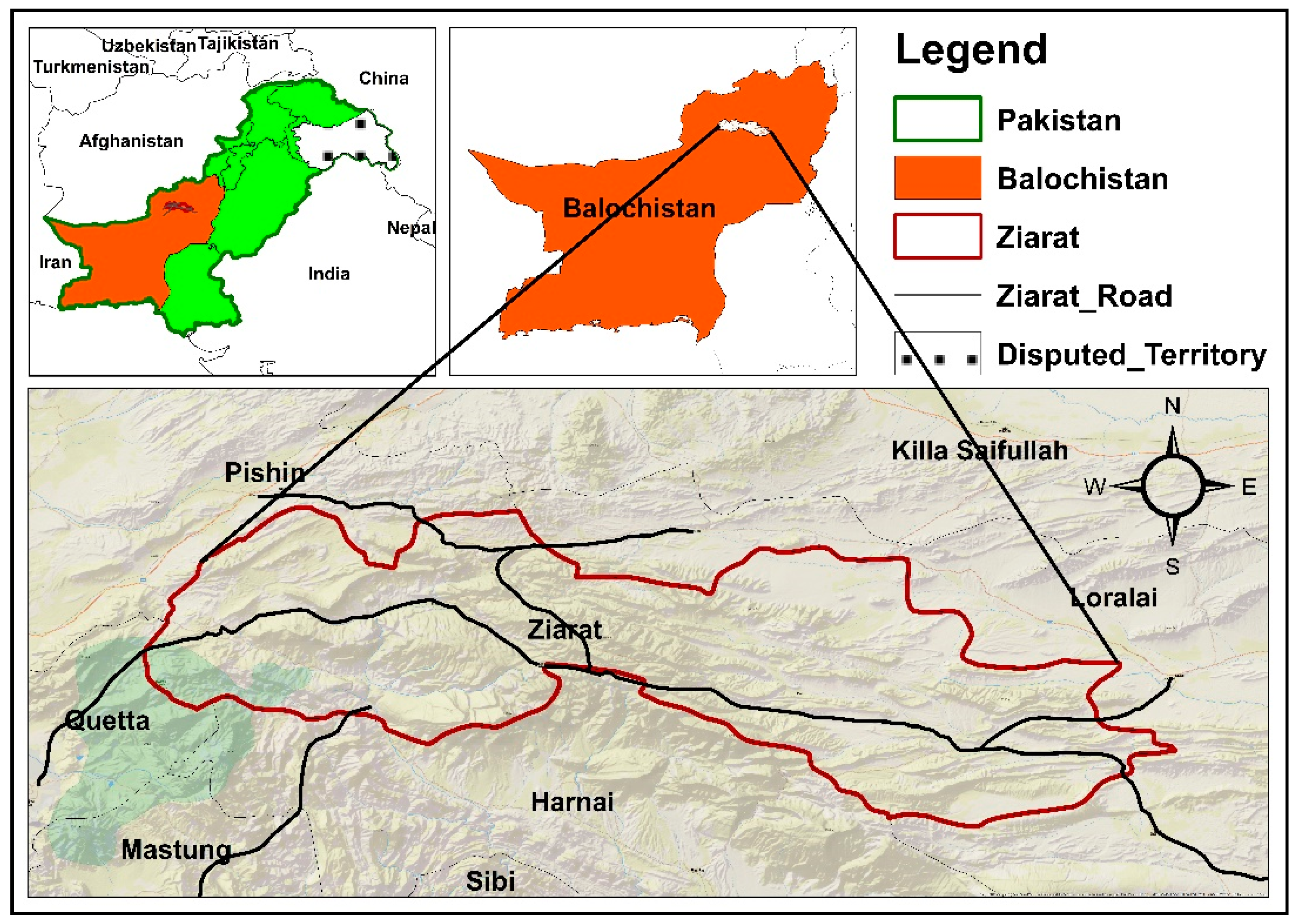
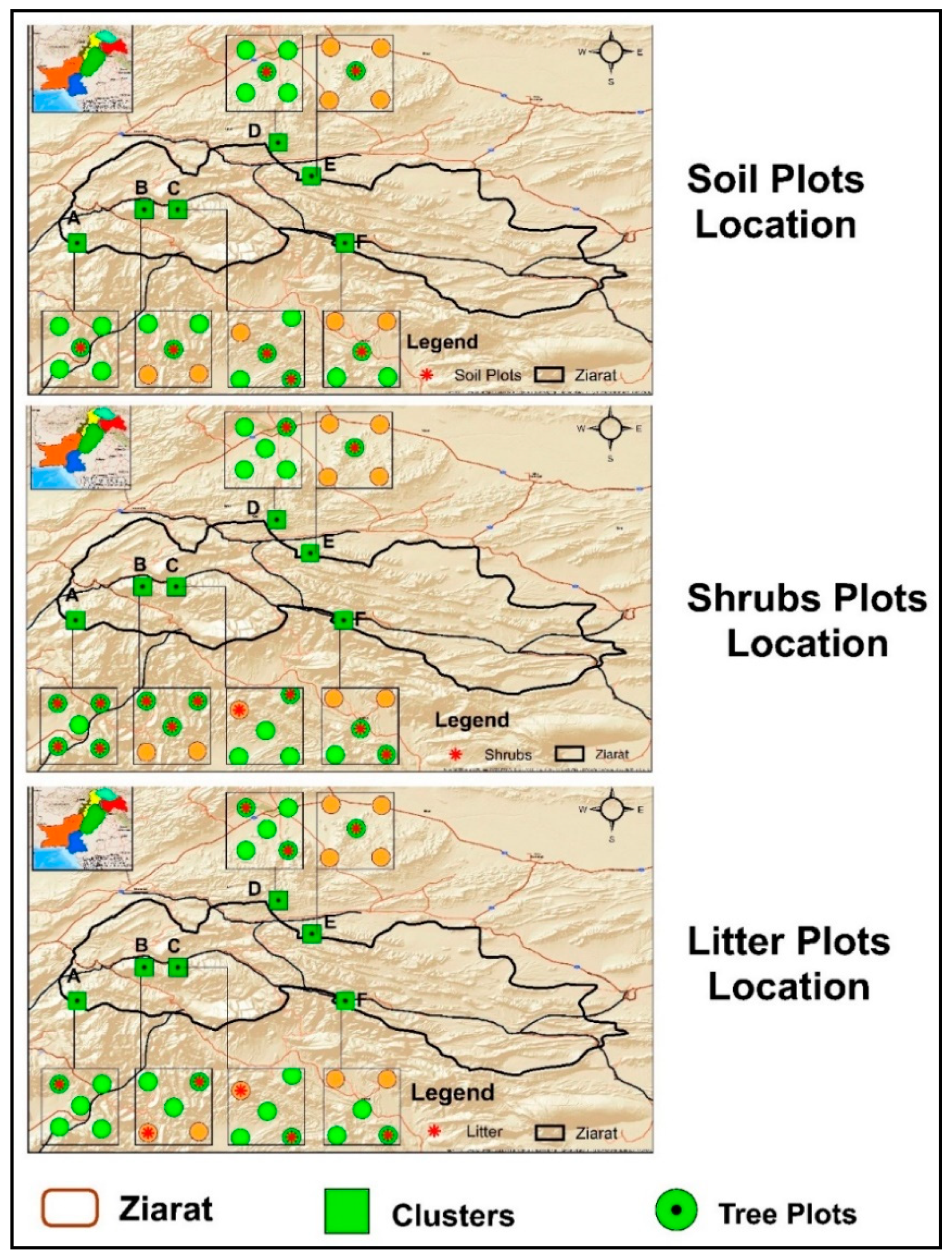
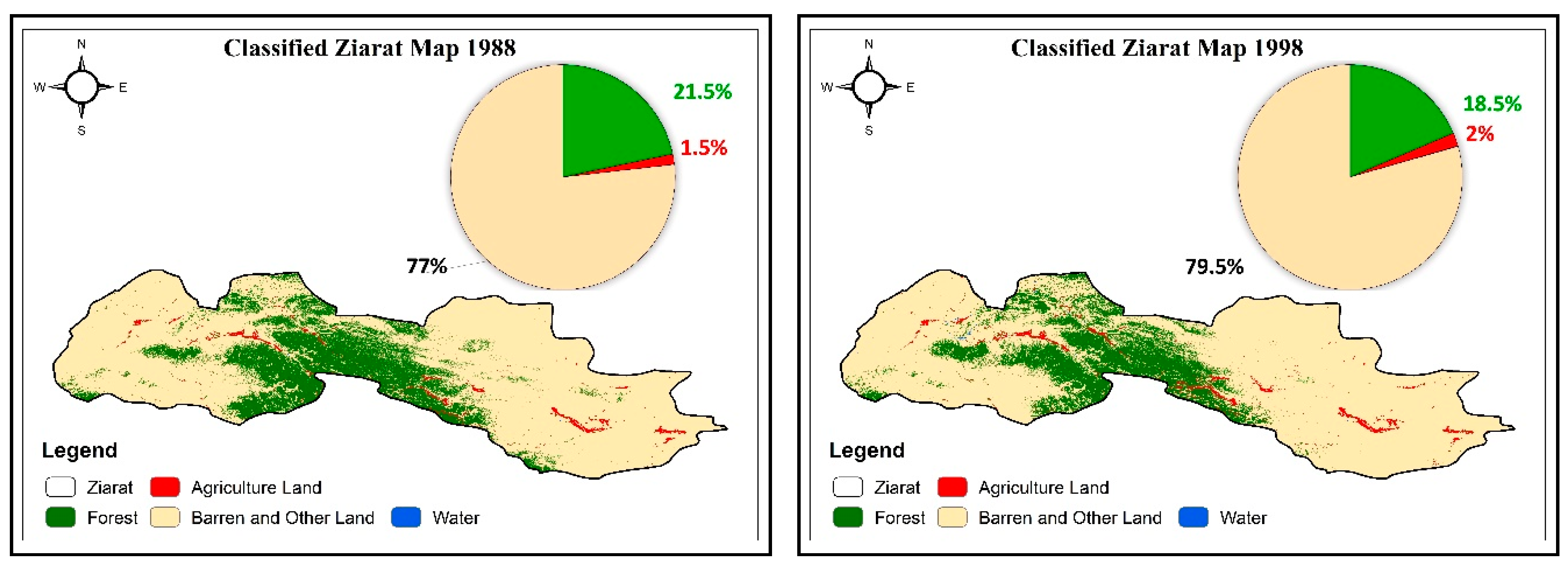
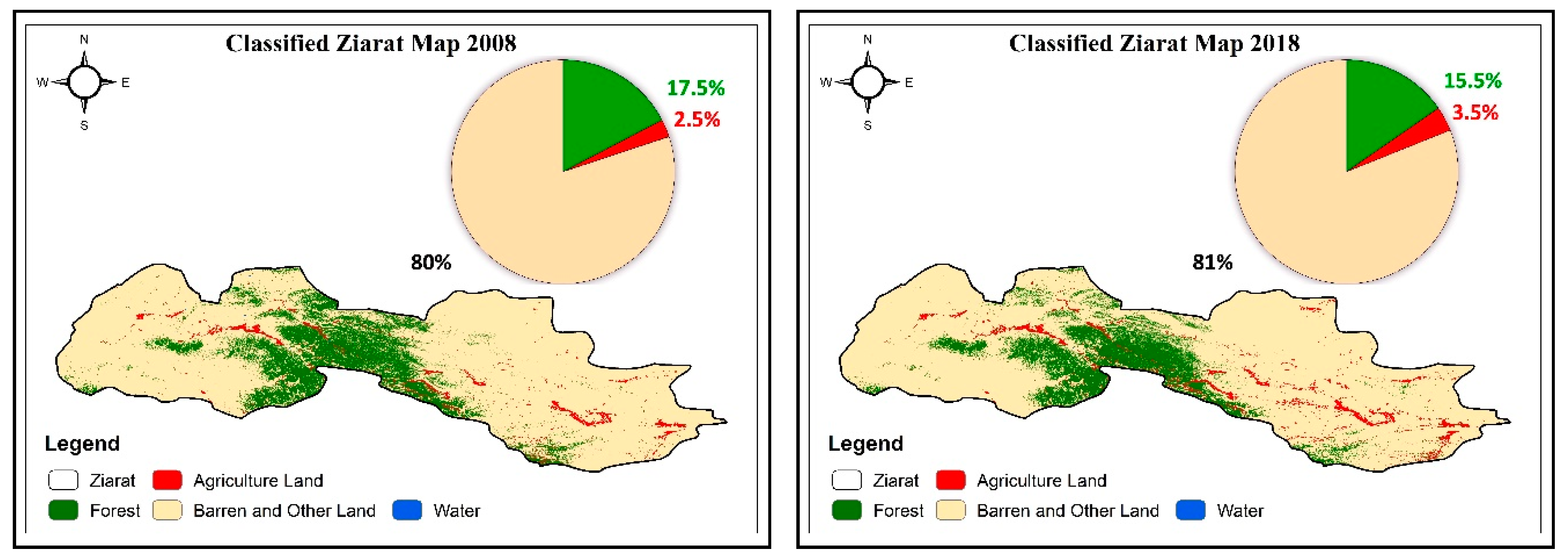
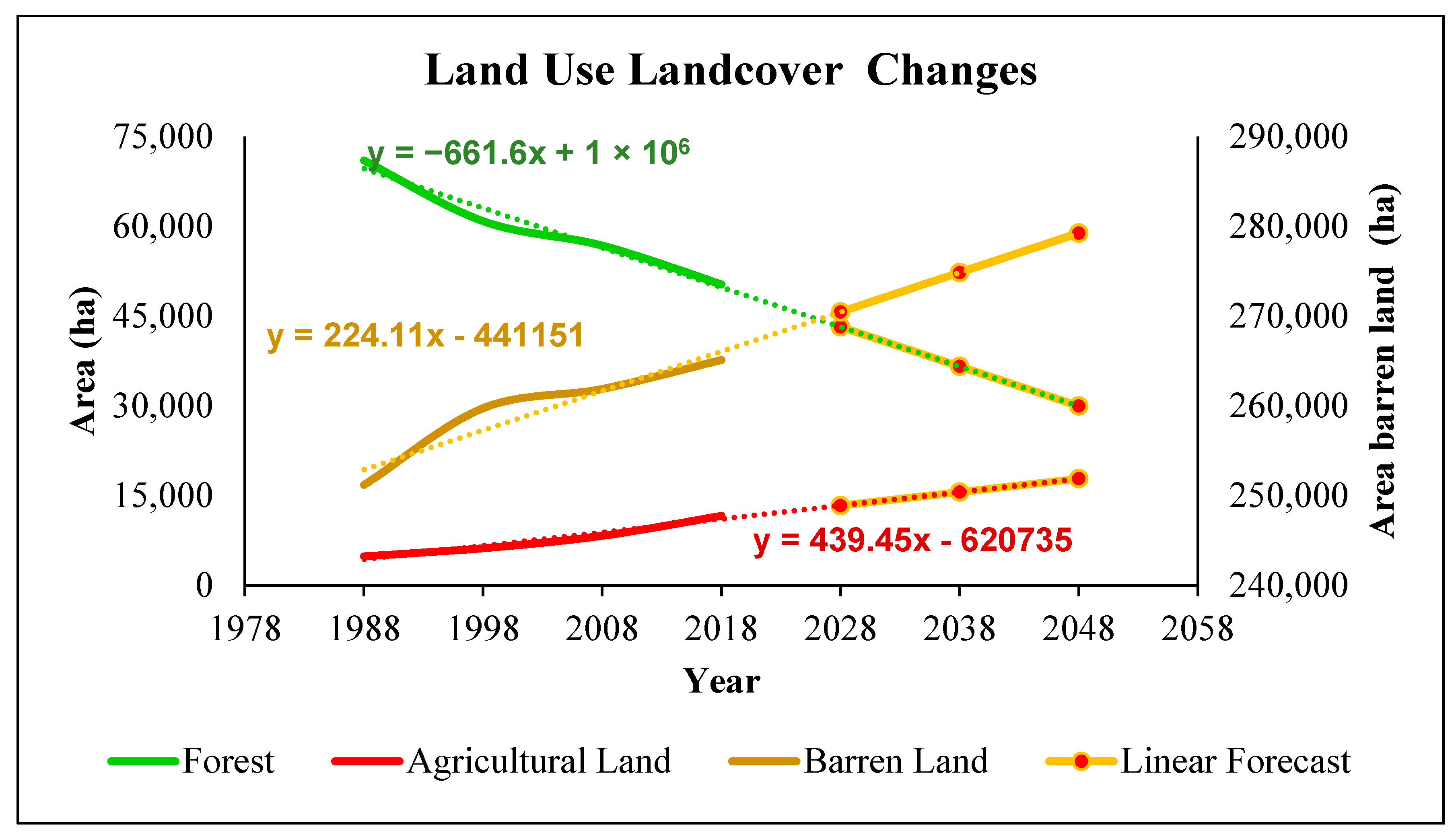
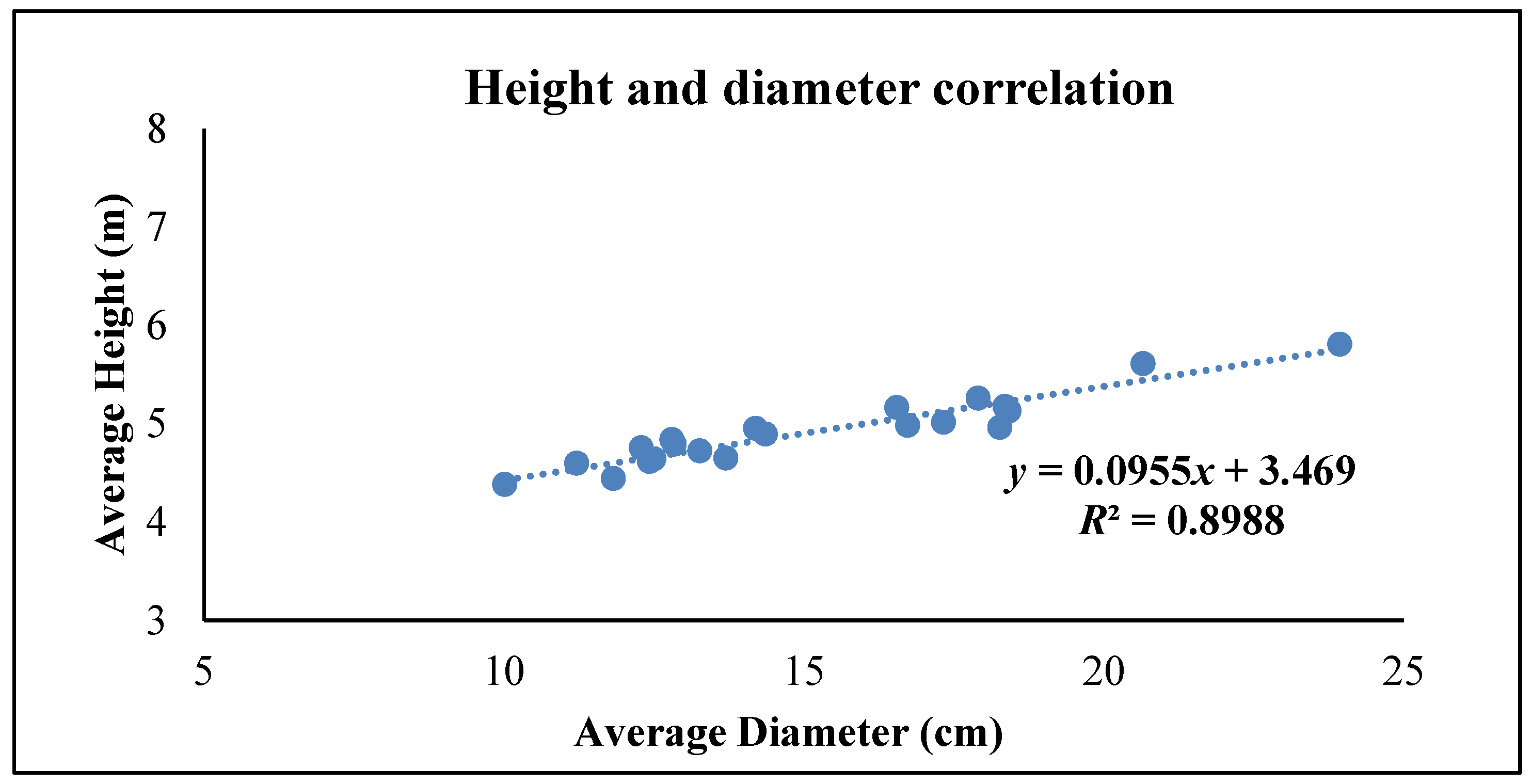
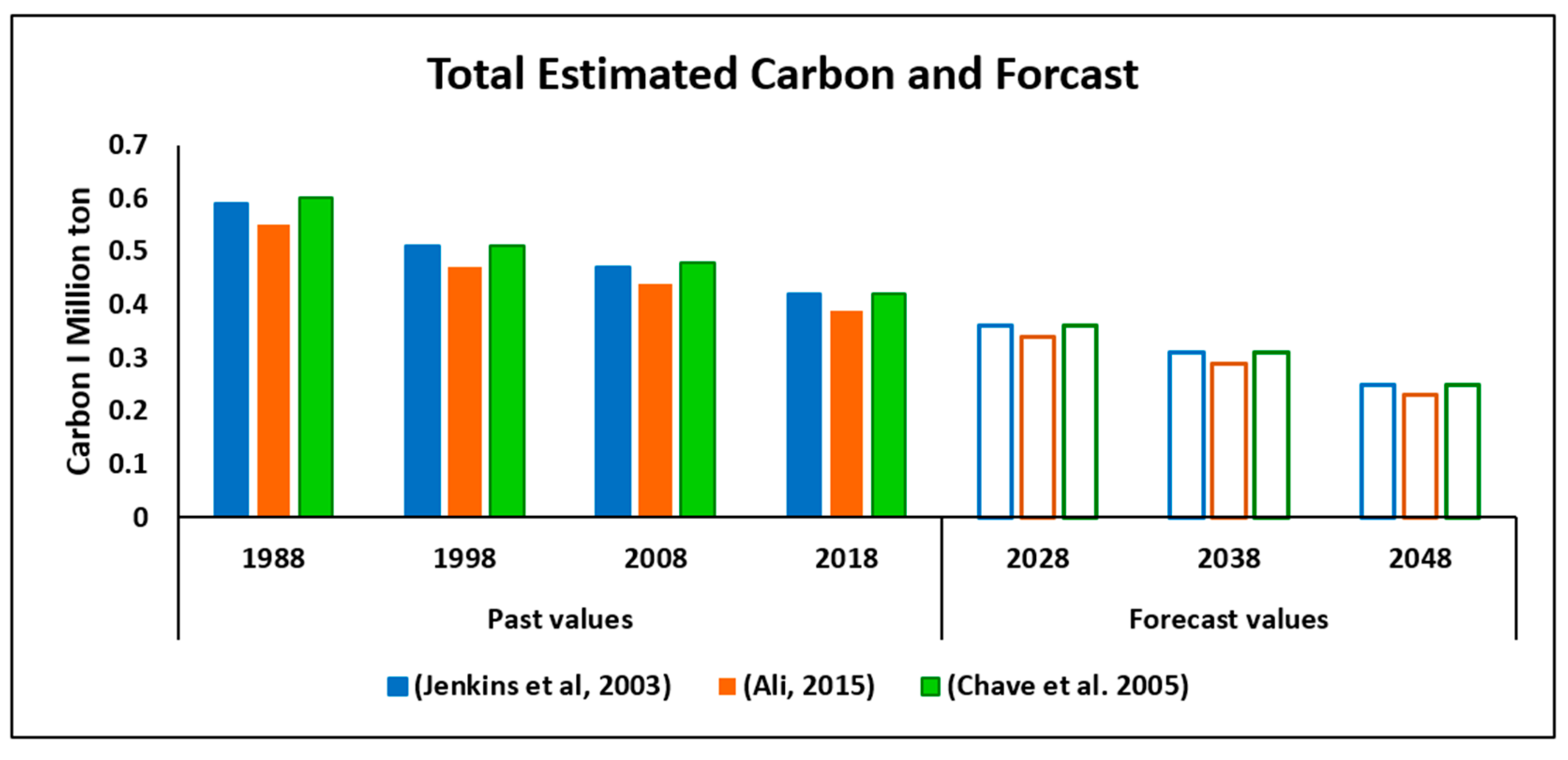
| Sensor | Year | Date | Bands (µm) |
|---|---|---|---|
| Landsat 8 OLI | 2018 | 10-September 17-September | Band 2 (0.45–0.51) |
| Band 3 (0.53–0.59) | |||
| Band 4 (0.64–0.67) | |||
| Band 5 (0.85–0.88) | |||
| Band 6 (1.57–1.65) | |||
| Band 7 (2.11–2.29) | |||
| Landsat 5 TM | 2008 | 30-September | Band 1 (0.45–0.52) |
| 21-September | Band 2 (0.52–0.60) | ||
| 1998 | 03-September | Band 3 (0.63–0.69) | |
| 10-September | Band 4 (0.77–0.90) | ||
| 1988 | 07-September | Band 5 (1.55–1.75) | |
| 14-September | Band 7 (2.09–2.35) |
| Jenkin et al. (2003) Equation | Ali. (2015) Equation | Chave et al. (2005) Equation |
|---|---|---|
| EXP (−0.7152 + 1.7029 × LN(DBH)) | 0.1645 × (p × D^2 × H)^0.8586 | EXP (−2.187 + 0.916 × LN(WD × DBH^2 × H)) |
| 1988 | 1998 | 2008 | 2018 | |||||
|---|---|---|---|---|---|---|---|---|
| Producer’s Accuracy % | User’s Accuracy % | Producer’s Accuracy % | User’s Accuracy % | Producer’s Accuracy % | User’s Accuracy % | Producer’s Accuracy % | User’s Accuracy % | |
| Forest | 92 | 100 | 100 | 100 | 94 | 100 | 92 | 100 |
| Agriculture | 100 | 100 | 100 | 100 | 100 | 100 | 100 | 100 |
| Barren and Other land | 100 | 92.59 | 100 | 100 | 100 | 94.33 | 100 | 92.59 |
| Water | 100 | 100 | 80 | 100 | 100 | 100 | 100 | 100 |
| Kappa Coefficient | 0.96 | 0.98 | 0.97 | 0.96 | ||||
| Overall Accuracy | 0.97 | 0.98 | 0.98 | 0.97 | ||||
| Plot ID | Number of Trees | Average Height (m) | Average Diameter (cm) | Basal Area (m2) |
|---|---|---|---|---|
| Plot 1 | 14 | 4.96 | 18.27 | 0.72 |
| Plot 2 | 20 | 4.65 | 13.71 | 0.48 |
| Plot 3 | 30 | 5.01 | 17.33 | 1.36 |
| Plot 4 | 22 | 4.60 | 11.22 | 0.25 |
| Plot 5 | 26 | 4.84 | 12.80 | 0.40 |
| Plot 6 | 24 | 5.26 | 17.91 | 0.85 |
| Plot 7 | 20 | 4.62 | 12.43 | 0.36 |
| Plot 8 | 24 | 5.16 | 16.55 | 0.67 |
| Plot 9 | 46 | 4.64 | 12.50 | 0.86 |
| Plot 10 | 23 | 5.13 | 18.43 | 0.97 |
| Plot 11 | 16 | 4.75 | 12.29 | 0.22 |
| Plot 12 | 21 | 4.79 | 12.84 | 0.33 |
| Plot 13 | 38 | 4.89 | 14.36 | 0.87 |
| Plot 14 | 58 | 4.72 | 13.27 | 1.29 |
| Plot 15 | 55 | 4.38 | 10.01 | 0.55 |
| Plot 16 | 21 | 4.44 | 11.83 | 0.36 |
| Plot 17 | 50 | 5.17 | 18.35 | 2.25 |
| Plot 18 | 16 | 5.81 | 23.94 | 0.98 |
| Plot 19 | 21 | 5.61 | 20.66 | 0.86 |
| Plot 20 | 35 | 4.98 | 16.73 | 1.23 |
| Plot 21 | 10 | 4.95 | 14.2 | 0.19 |
| 4.92 | 15.22 | 0.76 |
| Jenkin et al. (2003) | Ali (2015) | Chave et al. (2005) | ||||
|---|---|---|---|---|---|---|
| Serial no | Total Biomass kg | Total Volume m3 | Total Biomass kg | Total Volume m3 | Total Biomass kg | Total Volume m3 |
| Plot 1 | 1469.48 | 2.94 | 1525.63 | 3.05 | 1733.31 | 3.47 |
| Plot 2 | 1136.97 | 2.27 | 1042.32 | 2.08 | 1108.32 | 2.22 |
| Plot 3 | 2808.46 | 5.62 | 2882.99 | 5.77 | 3273.74 | 6.55 |
| Plot 4 | 726.67 | 1.45 | 564.27 | 1.13 | 551.60 | 1.10 |
| Plot 5 | 1092.21 | 2.18 | 894.63 | 1.79 | 898.08 | 1.80 |
| Plot 6 | 1969.00 | 3.94 | 1857.40 | 3.71 | 1998.63 | 4.00 |
| Plot 7 | 900.20 | 1.80 | 779.92 | 1.56 | 807.14 | 1.61 |
| Plot 8 | 1637.96 | 3.28 | 1471.67 | 2.94 | 1539.76 | 3.08 |
| Plot 9 | 2121.05 | 4.24 | 1868.06 | 3.74 | 1959.28 | 3.92 |
| Plot 10 | 2148.44 | 4.30 | 2109.62 | 4.22 | 2317.58 | 4.64 |
| Plot 11 | 589.45 | 1.18 | 476.99 | 0.95 | 475.87 | 0.95 |
| Plot 12 | 889.08 | 1.78 | 725.82 | 1.45 | 725.00 | 1.45 |
| Plot 13 | 2139.73 | 4.28 | 1907.67 | 3.82 | 1999.62 | 4.00 |
| Plot 14 | 3057.40 | 6.11 | 2791.66 | 5.58 | 2988.37 | 5.98 |
| Plot 15 | 1567.66 | 3.14 | 1217.62 | 2.44 | 1200.58 | 2.40 |
| Plot 16 | 826.38 | 1.65 | 778.57 | 1.56 | 851.04 | 1.70 |
| Plot 17 | 4782.44 | 9.56 | 4805.25 | 9.61 | 5381.93 | 10.76 |
| Plot 18 | 2107.65 | 4.22 | 2115.15 | 4.23 | 2346.73 | 4.69 |
| Plot 19 | 2021.00 | 4.04 | 1893.39 | 3.79 | 2019.08 | 4.04 |
| Plot 20 | 2786.63 | 5.57 | 2679.93 | 5.36 | 2914.52 | 5.83 |
| Plot 21 | 503.65 | 1.01 | 423.55 | 0.85 | 428.50 | 0.86 |
| Total | 37,281.51 | 74.56 | 34,812.12 | 69.62 | 37,518.67 | 75.04 |
| Serial. No | ABG (t/ha) Using Jenkin et al. (2003) Allometric Equation | ABG (t/ha) Using Ali (2015) Allometric Equation | ABG (t/ha) Using Chave et al. (2005) Allometric Equation |
|---|---|---|---|
| Plot 1 | 6.91 | 7.17 | 8.15 |
| Plot 2 | 5.34 | 4.90 | 5.21 |
| Plot 3 | 13.20 | 13.55 | 15.39 |
| Plot 4 | 3.42 | 2.65 | 2.59 |
| Plot 5 | 5.13 | 4.20 | 4.22 |
| Plot 6 | 9.25 | 8.73 | 9.39 |
| Plot 7 | 4.23 | 3.67 | 3.79 |
| Plot 8 | 7.70 | 6.92 | 7.24 |
| Plot 9 | 9.97 | 8.78 | 9.21 |
| Plot 10 | 10.10 | 9.92 | 10.89 |
| Plot 11 | 2.77 | 2.24 | 2.24 |
| Plot 12 | 4.18 | 3.41 | 3.41 |
| Plot 13 | 10.06 | 8.97 | 9.40 |
| Plot 14 | 14.37 | 13.12 | 14.05 |
| Plot 15 | 7.37 | 5.72 | 5.64 |
| Plot 16 | 3.88 | 3.66 | 4.00 |
| Plot 17 | 22.48 | 22.58 | 25.30 |
| Plot 18 | 9.91 | 9.94 | 11.03 |
| Plot 19 | 9.50 | 8.90 | 9.49 |
| Plot 20 | 13.10 | 12.60 | 13.70 |
| Plot 21 | 2.37 | 1.99 | 2.01 |
| Average | 8.34 | 7.79 | 8.40 |
| Serial. No | Soil Carbon ton/ha | Shrubs ton/ha | Litter ton/ha |
|---|---|---|---|
| Plot 1 | 28.06 | 0.057 | |
| Plot 2 | 0.045 | 2.22 | |
| Plot 3 | 0.033 | ||
| Plot 4 | 0.042 | ||
| Plot 5 | |||
| Plot 6 | 27.22 | 0.033 | 3.83 |
| Plot 7 | 0.075 | ||
| Plot 8 | 0.016 | 1.87 | |
| Plot 9 | 27.54 | ||
| Plot 10 | 0.085 | 1.37 | |
| Plot 11 | 0.102 | ||
| Plot 12 | 1.23 | ||
| Plot 13 | 17.76 | ||
| Plot 14 | 0.55 | ||
| Plot 15 | 0.066 | ||
| Plot 16 | 0.45 | ||
| Plot 17 | 0.047 | ||
| Plot 18 | 22.53 | 0.014 | 0.55 |
| Plot 19 | 22.99 | ||
| Plot 20 | 0.019 | 1.62 | |
| Plot 21 | 0.018 | ||
| Average | 24.35 | 0.05 | 1.52 |
Publisher’s Note: MDPI stays neutral with regard to jurisdictional claims in published maps and institutional affiliations. |
© 2020 by the authors. Licensee MDPI, Basel, Switzerland. This article is an open access article distributed under the terms and conditions of the Creative Commons Attribution (CC BY) license (http://creativecommons.org/licenses/by/4.0/).
Share and Cite
Jallat, H.; Khokhar, M.F.; Kudus, K.A.; Nazre, M.; Saqib, N.u.; Tahir, U.; Khan, W.R. Monitoring Carbon Stock and Land-Use Change in 5000-Year-Old Juniper Forest Stand of Ziarat, Balochistan, through a Synergistic Approach. Forests 2021, 12, 51. https://doi.org/10.3390/f12010051
Jallat H, Khokhar MF, Kudus KA, Nazre M, Saqib Nu, Tahir U, Khan WR. Monitoring Carbon Stock and Land-Use Change in 5000-Year-Old Juniper Forest Stand of Ziarat, Balochistan, through a Synergistic Approach. Forests. 2021; 12(1):51. https://doi.org/10.3390/f12010051
Chicago/Turabian StyleJallat, Hamayoon, Muhammad Fahim Khokhar, Kamziah Abdul Kudus, Mohd Nazre, Najam u Saqib, Usman Tahir, and Waseem Razzaq Khan. 2021. "Monitoring Carbon Stock and Land-Use Change in 5000-Year-Old Juniper Forest Stand of Ziarat, Balochistan, through a Synergistic Approach" Forests 12, no. 1: 51. https://doi.org/10.3390/f12010051
APA StyleJallat, H., Khokhar, M. F., Kudus, K. A., Nazre, M., Saqib, N. u., Tahir, U., & Khan, W. R. (2021). Monitoring Carbon Stock and Land-Use Change in 5000-Year-Old Juniper Forest Stand of Ziarat, Balochistan, through a Synergistic Approach. Forests, 12(1), 51. https://doi.org/10.3390/f12010051








